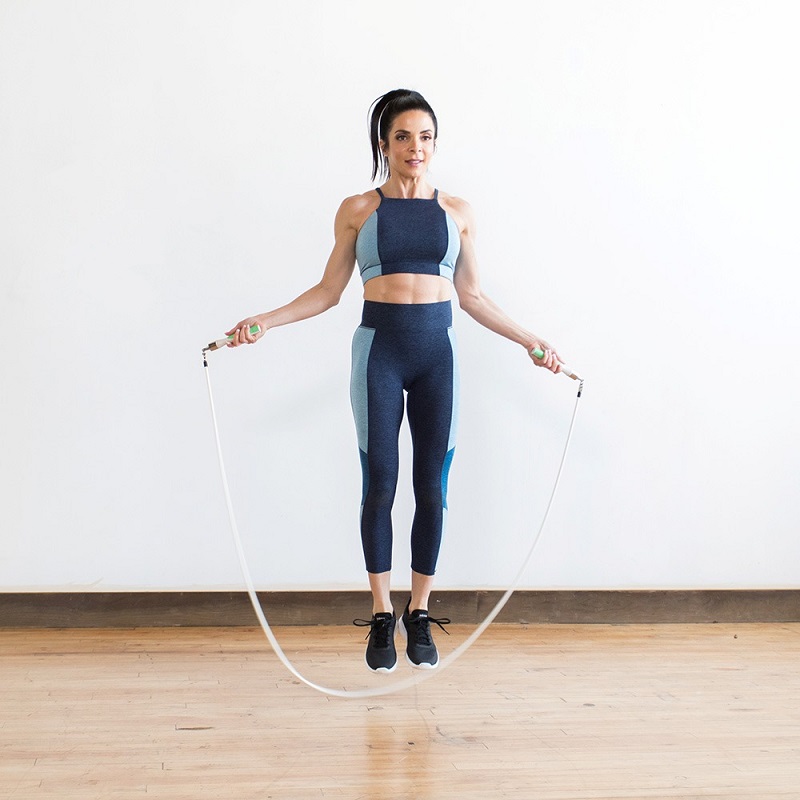Introduction
When it comes to effective cardio workouts, jump rope vs running are two popular exercises that often come to mind. Both methods provide excellent cardiovascular benefits, yet each has unique features and advantages that may make one more suitable for you than the other. Consequently, determining which workout is best for your fitness goals can be challenging.
Understanding the differences between these forms of exercise can significantly influence your workout routine. In this article, we will explore the benefits of jumping rope compared to running, identify which exercise is more effective for various fitness goals, analyze calorie burn, and provide insights to help you make the best choice for your lifestyle. By the end, you will have a clearer understanding of how jump rope and running stack up against each other, enabling you to select the workout that fits your needs.
Jump Rope: A Fun and Efficient Cardio Workout
Jumping rope has long been recognized as a fun and efficient way to elevate your heart rate. This exercise appeals not only to athletes but can also be easily integrated into anyone’s fitness routine, whether at home or in a gym setting.
Benefits of Jump Rope
A variety of benefits make jumping rope appealing to many people:
- Calorie Burn: As a cardio workout, jumping rope is highly efficient for burning calories. On average, you can burn about 10 to 16 calories per minute, depending on your weight and workout intensity. This means that in a 30-minute session, you could burn anywhere from 300 to 480 calories.
- Coordination and Agility: Engaging in jump rope exercises regularly enhances coordination and overall agility. Improved coordination is crucial not only for sports performance but also for everyday activities.
- Cardiovascular Endurance: Jumping rope effectively boosts your cardiovascular health, leading to better heart and lung function. By continuously raising your heart rate, your body learns to utilize oxygen more efficiently.
- Flexibility and Strength: This exercise engages multiple muscle groups, contributing to enhanced muscle tone and flexibility, particularly in the calves, quadriceps, and core. Therefore, such multi-muscle engagement improves your overall athletic performance.
- Adaptability: One of the key advantages of jump rope lies in its adaptability to your fitness level. You can easily adjust your workout based on your goals, whether aiming for a low-intensity warm-up or a high-intensity cardio session. Moreover, various techniques—such as single-leg jumps, double-unders, and criss-crosses—keep workouts engaging and enjoyable.
Convenience and Accessibility
Jump rope also offers extreme convenience. You can perform a workout almost anywhere, including your home, a park, or even while traveling. All you need is a decent quality rope, and you’re set. This ease means you can quickly fit a cardio workout into your busy day without needing to travel to a gym. Another positive aspect is that jump ropes are relatively inexpensive compared to many other fitness equipment options, making them highly accessible.

Running: The Classic Cardio Exercise
Running has long been regarded as a classic form of cardiovascular exercise. It stands out as a universal workout, providing countless benefits that have contributed to its popularity among fitness enthusiasts.
Benefits of Running
This activity presents a wealth of advantages that cater to various fitness goals:
- Calorie Burn: Running also expends a significant number of calories, averaging about 10 to 15 calories per minute depending on your speed, weight, and intensity. For instance, a person weighing 160 pounds running at 6 miles per hour can burn approximately 660 calories in just one hour.
- Enhanced Bone Density: As a weight-bearing exercise, running helps to improve bone density over time. Increasing bone density is essential for preventing osteoporosis and maintaining bone health.
- Mental Health Boost: The endorphins released during running can significantly improve your mood while reducing feelings of anxiety and depression. Many individuals experience what is commonly referred to as the “runner’s high,” a euphoric state derived from physical exertion.
- Goal Setting and Achievements: By providing clear benchmarks for improvement—such as distance, pace, or race participation—running enables you to set and track your progress, contributing to motivation and a sense of accomplishment.
- Strengthens Lower Body Muscles: Regular running builds strength in various muscle groups, particularly those in the lower body, including your quadriceps, hamstrings, calves, and glutes. This strength development can enhance performance in multiple sports activities.
Accessibility and Community
While running has its advantages, it also presents certain challenges. However, it remains a favorite choice for many because of its accessibility. Nearly anyone can run with just a good pair of running shoes. Moreover, the running community offers numerous clubs, events, and competitions. Joining a local running club provides opportunities for camaraderie, motivation, and accountability. Many runners enjoy participating in community races, which foster achievement and a sense of belonging.

Comparing Caloric Burn: Jump Rope vs Running
Caloric burn is an essential consideration when evaluating jump rope and running. Both exercises yield effective results; however, their outcomes depend on various factors.
Caloric Burn for Jump Rope
Jump rope is known for its high caloric expenditure. Studies indicate that this exercise typically burns around 10 to 16 calories per minute. For example, in a vigorous 30-minute session, participants could potentially burn between 300 to 480 calories, depending on their intensity level and body composition.
Caloric Burn for Running
In comparison, running can also burn calories at a similar or even slightly higher rate. An individual weighing 160 pounds who runs at a moderate pace of 6 miles per hour may burn approximately 660 calories within one hour. Consequently, during a 30-minute session, that person would burn around 330 calories, which is on par with a jump rope workout.
Factors Influencing Calorie Burn
Ultimately, several factors play a critical role in determining how many calories are burned during both activities:
- Body Weight: Heavier individuals generally burn more calories during any form of exercise, including both running and jumping rope.
- Intensity: The effort put into your workout directly correlates with calories burned. Engaging in high-intensity interval training (HIIT) with jump rope can elevate your heart rate significantly.
- Duration: Longer workouts naturally yield higher caloric burn. If you aim for a workout duration exceeding 30 minutes, the overall caloric expenditure will likely increase dramatically.
- Metabolism: Your metabolism significantly influences how effectively you burn calories. Individuals with faster metabolisms typically see higher totals during their workouts.

Suitability for Different Fitness Levels
Selecting between jump rope and running is largely dependent on your fitness level. Each activity presents distinct challenges and benefits suited for varying experience levels.
Beginners
- Jump Rope: For novices, jumping rope serves as an excellent introduction to cardiovascular fitness and coordination. Beginners should start slowly with basic jumps, concentrating on mastering proper form before attempting advanced techniques.
- Running: For those new to fitness, running might pose more challenges, especially if they lack a solid foundation. Utilizing structured programs like Couch to 5K can help ease new runners into the sport effectively.
Intermediate
- Jump Rope: More experienced jumpers can incorporate advanced techniques, such as double unders or crossovers, which add variety and increase workout intensity.
- Running: Intermediate runners can focus on enhancing both speed and distance by incorporating intervals and longer runs into their routines, leading to improved endurance and performance.
Advanced
- Jump Rope: Advanced jumpers may experience significant benefits from agility drills or incorporating jump rope into high-intensity interval training (HIIT) workouts for maximum effectiveness and cardiovascular endurance.
- Running: For advanced runners, opportunities for marathon training or competitive club participation provide avenues to foster community involvement and personal challenges while pushing their limits.

Joint Health: Impact on the Body
Both jump rope and running affect your joints differently, making joint health a significant concern when deciding on your workout routine.
Joint Impact of Jump Rope
Jump rope is generally classified as a low-impact exercise, especially when performed correctly. By selecting a forgiving surface or practicing controlled movements, you can minimize the risk of straining your joints. This characteristic makes it suitable for a wider range of fitness levels while protecting against injuries when done mindfully. Additionally, adequate warm-up exercises can help prevent discomfort in your joints and prepare your body for the workout.
Joint Impact of Running
Conversely, running is identified as a high-impact exercise, which can lead to joint pain over time. Factors such as improper footwear, poor running form, and inadequate warm-ups can exacerbate joint issues. As a result, individuals with pre-existing joint problems or injuries might find running particularly challenging. However, many runners effectively manage joint health by investing in proper footwear, maintaining a gradual increase in running distances, and ensuring consistency in their training plans.

The Social Aspect of Jump Rope and Running
While both exercises can be performed alone, social interaction often enhances the overall experience.
Jump Rope Communities
Jump rope presents a unique opportunity to connect with others. Many gyms or community centers offer jump rope classes or group sessions that allow participants to practice together. Furthermore, social media and online communities provide vibrant platforms for jump rope enthusiasts to share tips, techniques, and challenges, creating a supportive environment for growth.
Running Groups and Events
Running boasts a lively community with numerous clubs and events. Joining a local running group not only fosters camaraderie but also encourages commitment, facilitating shared goals that enhance motivation. Many individuals also find joy in participating in community races; these events contribute to both personal achievement and social connection while promoting healthy competition.

Conclusion
In conclusion, both jump rope vs running offer distinct benefits that can cater to various fitness goals and preferences. Jump rope serves as an enjoyable, efficient, and low-impact workout that enhances coordination, burns calories effectively, and develops strength. In contrast, running provides impressive calorie burn, improves mental well-being, and encourages social involvement.
When deciding between the two workouts, evaluate the advantages each one offers, along with your fitness level, any existing health concerns, and your personal preferences. Ultimately, the best choice is one that you enjoy and can commit to over the long term. It may even benefit you to alternate between jump rope and running, creating a balanced approach to cardiovascular fitness.
Incorporating both jump rope and running into your routine allows you to enjoy the benefits of each exercise, ensuring a well-rounded fitness experience. So, whether you opt for jumping rope, going for a run, or engaging in both activities, the journey toward achieving your fitness goals is yours to define.
